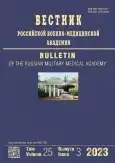Acute chemical pulmonary edema with inhaled nitrogen dioxide intoxication
- Authors: Tolkach P.G.1, Kuznetcov O.A.2, Basharin V.A.1, Lodyagin A.N.2, Shilov Y.V.1, Yazenok A.V.1, Ivchenko E.V.1, Zagorodnikov G.G.1
-
Affiliations:
- Kirov Military Medical Academy
- Dzhanelidze research institute of emergency medicine
- Issue: Vol 25, No 3 (2023)
- Pages: 471-479
- Section: Case report
- Submitted: 27.05.2023
- Accepted: 24.06.2023
- Published: 05.10.2023
- URL: https://journals.eco-vector.com/1682-7392/article/view/456484
- DOI: https://doi.org/10.17816/brmma456484
- ID: 456484
Cite item
Abstract
Nitrogen dioxide is released by the interaction of some metals with nitric acid. Inhalation intoxication with nitrogen dioxide leads to chemical pulmonary edema. This study presents the case of a patient who had acute inhalation exposure to an unidentified brown gaseous substance (presumably nitrogen dioxide) when he etched a metal product with nitric acid. Twenty-four hours after contact with the gas, he manifested signs of intoxication, such as chest pain, tachypnea, and decreased saturation. Laboratory tests revealed hemoconcentration, hyperfermentemia, and arterial hypoxemia. The X-ray image of the entire lung surface revealed a sharp increase and deformation of the pulmonary pattern due to the vascular component. The diagnosis was T65, i.e., toxic effect of other and unspecified substances. With treatment, the patient’s condition improved. On day 4 after therapeutic exposure, with decreased oxygen fraction in the inhaled gas mixture to 0.3, the saturation increased to 98%, and tachypnea disappeared. On day 6, with ongoing treatment (oxygen therapy, use of antioxidants, antihypoxants, anti-inflammatory, and antibacterial drugs), the inflammatory reaction stopped, the rheological properties of the blood improved, and the gas composition of arterial blood normalized, i.e., the oxygenation index was 436, which indicated the disappearance of arterial blood oxygenation disorders. During the radiological examination, the normal radiological picture of the lungs was determined. Thus, on day 6 after the start of therapy, signs of intoxication were completely stopped. Specific changes in the lungs during radiation research techniques, hemoconcentration, inflammation, and hypoxemia during laboratory blood tests should be considered prognostic signs of chemical pulmonary edema. As a pathogenetic therapy, treatment must be supplemented with drugs that stop the cascade of free radical oxidation reactions (acetylcysteine and sodium thiosulfate). Individuals exposed to nitrogen dioxide should be considered a high-risk group for lung damage and hospitalized for dynamic observation for at least 2 days. Taking into account the genotoxic effects of nitrogen dioxide, affected patients should be classified as at risk of developing neoplasms and undergo further dynamic monitoring.
Full Text
About the authors
Pavel G. Tolkach
Kirov Military Medical Academy
Author for correspondence.
Email: pgtolkach@gmail.com
ORCID iD: 0000-0001-5013-2923
SPIN-code: 4304-1890
Scopus Author ID: 56649299800
MD, Dr. Sci. (Med.)
Russian Federation, Saint PetersburgOleg A. Kuznetcov
Dzhanelidze research institute of emergency medicine
Email: kuznetcov_dr@inbox.ru
ORCID iD: 0000-0002-1275-9570
SPIN-code: 4656-5700
Scopus Author ID: 37000781800
ResearcherId: G-4585-2015
MD, Cand. Sci. (Med.)
Russian Federation, Saint PetersburgVadim A. Basharin
Kirov Military Medical Academy
Email: basharin1@mail.ru
SPIN-code: 4671-8386
Scopus Author ID: 6507336085
MD, Dr. Sci. (Med.), professor
Russian Federation, Saint PetersburgAlexey N. Lodyagin
Dzhanelidze research institute of emergency medicine
Email: alodyagin@mail.ru
SPIN-code: 4886-8890
MD, Dr. Sci. (Med.), docent
Russian Federation, Saint PetersburgYurii V. Shilov
Kirov Military Medical Academy
Email: imshilov@yandex.ru
SPIN-code: 4765-0848
MD, Cand. Sci. (Med.)
Russian Federation, Saint PetersburgArkadii V. Yazenok
Kirov Military Medical Academy
Email: arkyazenok@yandex.ru
Scopus Author ID: 56152793900
MD, Dr. Sci. (Med.), docent
Russian Federation, Saint PetersburgEvgenii V. Ivchenko
Kirov Military Medical Academy
Email: 8333535@mail.ru
ORCID iD: 0000-0001-5582-1111
SPIN-code: 5228-1527
Scopus Author ID: 57311062800
MD, Dr. Sci. (Med.), docent
Russian Federation, Saint PetersburgGennadii G. Zagorodnikov
Kirov Military Medical Academy
Email: gen73zag@mail.ru
ORCID iD: 0000-0002-4859-0519
SPIN-code: 4465-5572
Scopus Author ID: 55338979400
MD, Dr. Sci. (Med.)
Russian Federation, Saint PetersburgReferences
- Tiunov LA, Golovko NYa, Galkin BN, Barinov VA. Biokhimicheskie mekhanizmy toksichnosti oksidov azota. Uspekhi sovremennoi biologii. 1991;111(5):738–750. (In Russ.).
- Basharin VA, Chepur SV, Tolkach PG, et al. Toksikologiya produktov goreniya polimernykh materialov: uchebnoe posobie. Saint Petersburg: Levsha; 2022. 104 p. (In Russ.).
- Korshunov AV, Kovaleva SV, Gladyshev VP. Vliyanie kontsentratsii azotnoi kisloty na sostav produktov ee vosstanovleniya pri vzaimodeistvii s med’yu. Bulletin of the Tomsk Polytechnic University. 2004;307(3):86–89. (In Russ.).
- Gembitskii EV, Bogdanov NA, Safronov VA. Ostrye i khronicheskie otravleniya azotnoi kislotoi i okislami azota. Leningrad: Meditsina, 1974. 159 p. (In Russ.).
- Basharin VA, Chepur SV, Tolkach PG, et al. Toksikologiya pul’monotoksikantov: uchebnoe posobie. Saint Petersburg: Levsha; 2021. 87 p. (In Russ.).
- Basharin VA, Chepur SV, Shchegolev AV, et al. The role and place of respiratory support in the treatment regimens for acute pulmonary edema caused by inhalation of toxic substances. Russian Military Medical journal. 2019;340(11):26–32. (In Russ.). doi: 10.17816/RMMJ81664
- GNIII VM MO RF. Metodicheskie rekomendatsii po terapii dykhatel’noi nedostatochnosti u porazhennykh otravlyayushchimi i vysokotoksichnymi veshchestvami na ehtapakh meditsinskoi ehvakuatsii. Saint Petersburg; 2016. 55 p. (In Russ.).
- Meulenbelt J, Sangster B. Acute nitrous oxide intoxication: clinical symptoms, pathophysiology and treatment. Neth J Med. 1990;37 (3-4):132–138.
- Sherbasov KA, Basharin VA, Marysheva VV, et al. Experimental estimation of efficiency of antihypoxants at toxic pulmonary edema caused by nitrogen oxide (IV). Reviews on Clinical Pharmacology and Drug Therapy. 2016;14(2):65–68. (In Russ.). doi: 10.17816/RCF14265-68
- Lindvall T. Health effects of nitrogen dioxide and oxidants. Scand J Work Environ Health. 1985;11(S3):10–28.
- Yaroshetsky AI, Gritsan AI, Avdeev SN, et al. Diagnostics and intensive therapy of Acute Respiratory Distress Syndrome (Clinical guidelines of the Federation of Anesthesiologists and Reanimatologists of Russia). Russian Journal of Anesthesiology and Reanimatology. 2020;(2):539. (In Russ.). doi: 10.17116/anaesthesiology20200215
- Moroz VV, Golubev AM, Kuzovlev AN. Pulmonary edema: Classification, mechanisms of development, diagnosis. General Reanimatology. 2009;(1):83–88. (In Russ.).
Supplementary files










